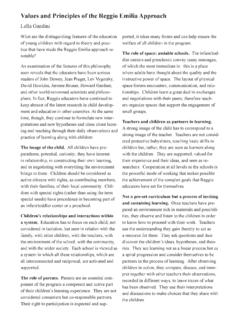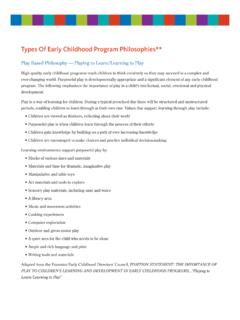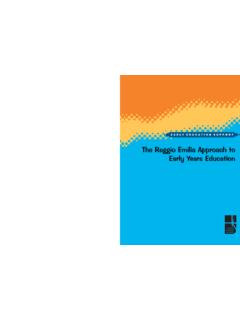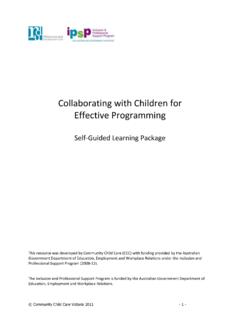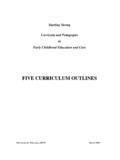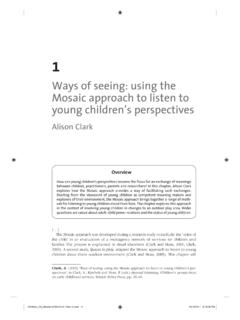Transcription of Reggio Emilia: An Essential Tool to Develop Critical ...
1 JOURNAL OF NEW APPROACHES IN EDUCATIONAL RESEARCH. Vol. 6. No. 1. January 2017. pp. 50 56 ISSN: 2254-7339 DOI: ORIGINAL. Reggio emilia : An Essential tool to Develop Critical Thinking in Early Childhood Merc Fern ndez Sant n1* , Maria Feliu Torruella2. 1. Department of Education of Social Sciences, Musical Education and Visual and Plastic Education, University of Barcelona, Barcelona, Spain 2. Department of Education of Social Sciences, Musical Education and Visual and Plastic Education, University of Barcelona, Barcelona, Spain Received on 5 September 2016; revised on 26 September 2016; accepted on 14 October 2016; published on 15 January 2017. DOI: allows us to draw conclusions. On the other hand authors like ABSTRACT Eisner (2002), Sans and Balada (2004; 2008), Acaso (2009). We seem to have a problem in arts education at pre-school level: mention the importance of changing attitudes and practices in the lack of specific training for teachers teaching this subject to relation to arts education at preschool level.
2 Very young children. The future preschool teachers' training Teachers undergoing training should consider two different seems to be focused on the teaching and learning aspects of strands: lack of training in arts and lack of training in pedagogy, artistic education however they receive little training on methodol- depending on the levels in which they are teaching. A good ogies and philosophies. Therefore, when teachers have to face example is described by Acaso (2009) who points out that in the classroom, the methodologies they use are usually quite Spain secondary education teachers have arts training but they traditional and do not favour the development of Critical thinking do not possess education and pedagogic related training, while skills in the students. There are different philosophies of arts primary school teachers have strong pedagogic training but they education that might embed opportunities for reflection, art inter- lack training and education in relation to arts.
3 Therefore, we pretation, experimentation, expression of emotions and feelings consider that teacher training in artistic education must point in that if, in the case these philosophies, reach the classroom, may two directions: a deep pedagogical improvement on teaching doubtlessly enrich the student's artistic training. Thus a conceptu- skills and knowledge including new theories, paradigms, al framework based on one of these philosophies, named Reggio methodologies and innovative means for teaching, and to emilia , arises. A systematic review of the literature which Develop strong knowledge in the arts, its movements and its has been developed by categorising criteria from research papers history, therefore, this study aims to provide a conceptual and from examples of good practices. This categorisation might framework that can help to fill the existing gaps in teachers allow us to establish a framework that can be useful in the class- education.
4 The core issue with the lack of knowledge in arts rooms and can establish parameters of action that may have an education is that it can strain the innovation in the classroom impact on students, teachers and teachers' practice in general. because teachers are missing key theoretical and philosophical elements to teach arts. In recent years, there has been some KEYWORDS: Reggio emilia , ART EDUCATION, Critical debate in schools to redesign arts teaching in preschool and THINKING primary school. However, there is a scarcity of consistent strategies to allow teachers, who are not being trained in arts 1 INTRODUCTION teaching, to Develop the full potential of arts education in the children's Critical thinking. Training for teachers teaching arts at preschool level seems to be To understand how art is taught at preschool level is key to missing from academic programmes as the training received by studying which are the most commonly used methods to teach future preschool teachers is far from what would be ideal.
5 Arts to young children in order to determine whether the use of Therefore, we find arts teachers who have not studied fine arts methods such as the Reggio emilia approach are effective to and arts history or that have only studied a couple of subjects Develop creativity in young children. throughout their teaching training programmes. Our research is based on the concept of the arts atelier, which Although there seems to be an education renewal in regards to is at the heart of the educational model developed by Loris training teachers, it is not yet visible in the classrooms. Besides, Malaguzzi at Reggio emilia . It can be understood as a there is very little research in preschool arts education that philosophical approach which is focused on listening and respecting children and their potential by witnessing their actions towards reformulating everyday practices, ideas and * To whom correspondence should be addressed: projects.
6 The approach proposes a participatory and democratic educational system, that emphasises research and University of Barcelona, Factultad de Educaci n - Campus Mundet, experimentation and which is one of the many educational Secci n Departamental de Did ctica de las Ciencias Sociales, Edificio de Llevant, Despacho 125, Pg. Vall d'Hebron 171, 08035 Barcelona, approaches to arts education in childhood. Spain NAER Journal of New Approaches in Educational Research 2017 | 50. Reggio emilia : An Essential tool to Develop Critical Thinking in Early Childhood We understand arts education as the one of the types of To support the implementation of the Reggio emilia 's atelier educational models that allows the awakening of Critical in schools, in this paper a conceptual framework is presented thinking from artistic works as Critical thinking is achieved when towards facilitating the adoption of a model able to help teachers attitudes, emotion and expression of feelings are developed and in training.
7 This conceptual framework can be useful in the arts when reflection and interpretation are stimulated. Thus, arts education classrooms, as it establishes parameters that can have education contributes to the children's Critical thinking. an impact on students, teachers and in the methodology in The Reggio emilia approach promotes art education, which is general. seen as a way to Develop Critical and scientific thinking through artistic work, stimulating values and encouraging children to 2 CONCEPTUAL BACKGROUND. express their feelings, promoting the development of communication and social skills and motivating cooperative With regards to the concept of arts education, this has changed work and discussion as key elements in a free and democratic its focus and trends over the time and is constantly evolving.
8 The society. (Ciari, 1961; New, 2007; Gonz lez, 2011). According to trends relating to arts education in schools, have been modified, New (2007), Reggio emilia 's municipal early childhood extended, corrected and reinvented. Throughout the literature program ( ) is committed not to the development of more and review, several trends in art education can be identified; such as better child artists, but to the development of creative, critically the Discipline-Based Art Education (DBAE) and the Bauhaus. thinking and collaboratively engaged citizens . The DBAE as model focuses on arts teaching through the Artistic training in early childhood education it is based on visual art and aims at four objectives: to create; to appreciate the plastic experimentation (colours, textures, materials) and on qualities; to relate art to its socio-cultural context, and to explain creating standardised projects in which freedom of expression and justify their own judgments.
9 The concept of Bauhaus, which and individual creativity is not yet present. Usually, Critical is related to the field of design and, at the school framework, thinking strategies are not embedded in arts education, which do seeks to help students to become aware of a variety of not seem to go beyond the strictly manual and plastic abilities. considerations of the economic, structural and aesthetic aspects When we limit our practices to this sort of methodology only we in the design process, which has to be the result of a personal do not Develop all the possibilities that arts teaching creative expression. philosophies can offer us. One of the pioneers in analysing visual thinking is Rudolph The most known or common methods of arts education can be Arnheim, who was influenced by the Gestalt and Hermeneutics understood as follows: Discipline-Based Art Education (DBAE); movements, in his book Visual Thinking (1969) he suggests that Bauhaus and Visual Thinking.
10 The authors behind arts related there are other ways of learning based on the senses, such as educational theories are Eisner, Gardner, Read, Lowenfeld, through vision. Therefore, following this line of thought we can Montessori and Waldorf. find Elliot W. Eisner and Howard Gardner amongst other Our main objective is to present a framework that can support theorists, both of whom developed their own approaches with the adoption of the atelier of Reggio emilia as a key element to regards to arts and creativity. Develop Critical thinking since early childhood from pre-school, Eisner (2002) considers artistic thinking as a dynamic, by supporting teachers to Develop strategies that can lead to relational, constructive and poetic construct that provides a establish an arts related pedagogical model.










